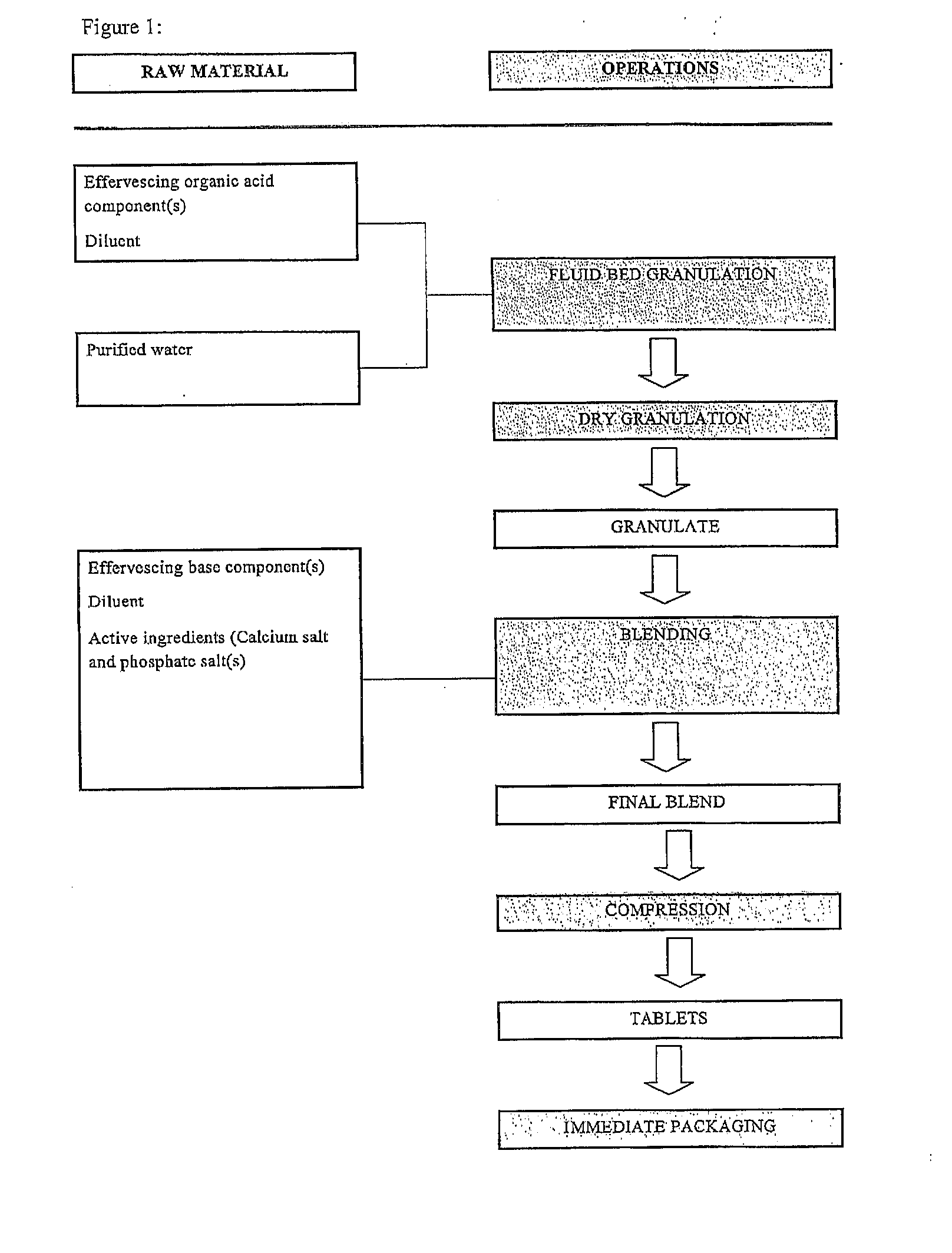Effervescent tablet
a tablet and effervescent technology, applied in the field of effervescent tablets, can solve the problems of reduced activity, severe dental injuries, severe oral cavity mucous membrane injury,
- Summary
- Abstract
- Description
- Claims
- Application Information
AI Technical Summary
Benefits of technology
Problems solved by technology
Method used
Image
Examples
example 1
Preparation of Effervescent Tablets
[0102]The suitable amount of effervescing organic acid component and the diluent was weight and sieved and tumble mixed for approx. 5 min at 8 rpm in order to homogenize the mixture. The obtained mixture was then granulated in a fluid bed granulated. The obtained granulate was dried (air temperature 60±10° C.), keeping the temperature below 65° C. until the residual humidity was below 0-0.20%. The granulate was then cooled, sieved and tumble mixed for 5 min at 8 rpm.
[0103]The suitable amounts of the remaining constituents (effervescing base component, active ingredients, etc.) was weighted and added into the granulate and mixed for 20 minutes at 8 rpm in order to homogenize the whole mixture.
[0104]The obtained mixture was compressed to tablet using a rotary tablet press equipped with punches of a convenient size, such as e.g. 18 mm or 25 mm diameter punches. A flow chart of the process is shown in FIG. 1.
example 2
Effervescent Tablet of 3000 mg
[0105]Effervescent tablets were prepared according to the method of described in example 1 comprising sodium hydrogen carbonate, anhydrous sodium carbonate as effervescing base component and anhydrous citric acid as effervescent agents, and sorbitol as a diluent and flavouring agent, respectively, in addition to the active ingredients. The amount of the ingredients is shown in table 1.
[0106]The specified amount of anhydrous citric acid powder and sorbitol was tumble mixed and subjected to fluid bed granulation according to the process described in example 1. After sieving and mixing of the granulate, the granulate was added to a bin comprising the remaining constituents, i.e. sodium hydrogen carbonate, anhydrous sodium carbonate, calcium chloride dihydrate, dibasic sodium phosphate, and monobasic sodium phosphate and mixed, and compressed to tablets. The theoretical weight of the tablets is 3000.000 mg.
TABLE 1NAMES OF INGREDIENTSUNIT FORMULASodium hydro...
example 3
Effervescent Tablet of 1200 mg
[0107]Effervescent tablets were prepared according to the method of described in example 1 comprising sodium hydrogen carbonate, anhydrous sodium carbonate as effervescing base component and anhydrous citric acid as effervescent agents, and sorbitol as a diluent and flavouring agent, respectively, and also maltodextrin as yet a diluent, in addition to the active ingredients. The amount of the ingredients is shown in table 2.
[0108]The specified amount of anhydrous citric acid powder and sorbitol was tumble mixed and subjected to fluid bed granulation according to the process described in example 1. After sieving and mixing of the granulate, the granulate was added to a bin comprising the remaining constituents, i.e. sodium hydrogen carbonate, anhydrous sodium carbonate, calcium chloride dihydrate, maltodextrin, dibasic sodium phosphate, and monobasic sodium phosphate and mixed, and compressed to tablets. The theoretical weight of the tablets is 1200.000 ...
PUM
| Property | Measurement | Unit |
|---|---|---|
| Time | aaaaa | aaaaa |
| Mass | aaaaa | aaaaa |
| Mass | aaaaa | aaaaa |
Abstract
Description
Claims
Application Information
 Login to View More
Login to View More - R&D Engineer
- R&D Manager
- IP Professional
- Industry Leading Data Capabilities
- Powerful AI technology
- Patent DNA Extraction
Browse by: Latest US Patents, China's latest patents, Technical Efficacy Thesaurus, Application Domain, Technology Topic, Popular Technical Reports.
© 2024 PatSnap. All rights reserved.Legal|Privacy policy|Modern Slavery Act Transparency Statement|Sitemap|About US| Contact US: help@patsnap.com








